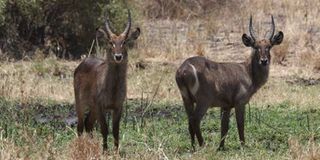KWS conducts first census of herbivores in Meru Park

Water bucks at the Meru National Park on September 19, 2016 as KWS and members of the BornFree Foundation concluded a two-day census of herbivores in the game reserve. PHOTO | PHOEBE OKALL | NATION MEDIA GROUP
What you need to know:
- The team that conducted the census noted an increase in the number of buffalos and their calves.
- The census starts at 6am when the sun is not too hot before animals disappear into the interior parts of the park.
- In 2014, during the aerial count targeting big mammals, 2,000 buffalos were recorded.
- A census on carnivores targeting lions was conducted in February and recorded about 58 of them in six prides.
The Kenya Wildlife Service and BornFree Foundation Tuesday concluded a two-day census of herbivores in the Meru National Park.
However, the report of the census will be released in a month’s time.
It was the first ever census of herbivores targeting all mammals at the park.
The team that conducted the census noted an increase in the number of buffalos and their calves.
In 2014, during the aerial count targeting big mammals, 2,000 buffalos were recorded.
However the park’s Eastern Conservation Area Senior Scientist Geoffrey Bundotich said the aerial count which is done after every three years is not “very accurate as medium-size and small mammals are never counted as they are not spotted.”
Mr Bundotich said the count was a pilot project to establish the species, numbers, age and sex structures.
PREY-PREDATOR RELATIONSHIP
“We are calculating the prey-predator relationship so that we can establish whether the ecosystem is balanced,” he said.
He went on: “The exercise went very well though the challenge was the road networks. We are hoping to repeat the exercise in March (2017) if funds allow.”
A census on carnivores targeting lions was conducted in February and recorded about 58 of them in six prides.
“The prides have since been given names. Six leopards were also collared and we are now developing photo identities for all cheetahs,” Mr Bundotich added.
BornFree Foundation country director Timothy Oloo said the census starts at 6am when the sun is not too hot, before animals disappear into the interior parts of the park, and ends at 10 am.
“After the poaching incidents in the 1980’s there was a reintroduction of animals into the park and it is important to make a follow-up on whether they are increasing or declining and why.
“We have, however, noted there were so many buffalos and giraffes and we are planning to fund another exercise in the wet season and compare the results. The ground count is very important,” Mr Oloo said.





